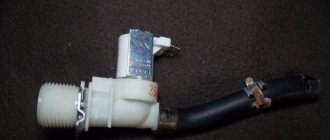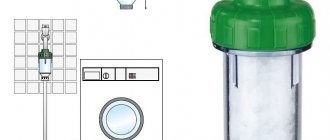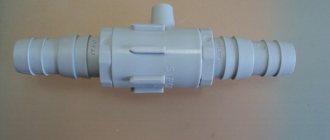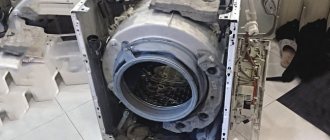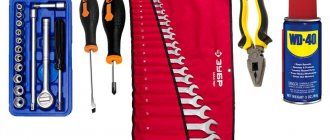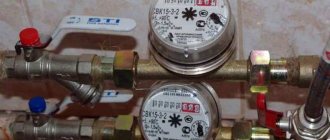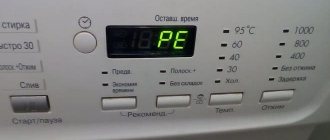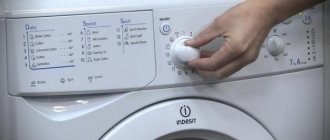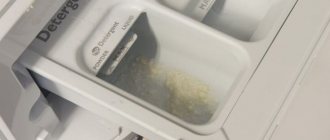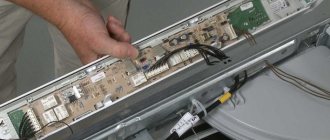Solenoid valves for connecting various devices to water supply systems are used quite often. Such devices have an electromechanical principle of operation and are a type of locking equipment. Experts call them solenoid (solenoid - magnet).
Solenoid shut-off elements are often found in various industries, in water and gas supply systems. In accordance with its functions, in washing machines this device is called a filler or inlet valve.
Repair and replacement
You can check the operation of the water supply in your washing machine using a simple test. First, you need to remove the valve from the unit and connect the hose to it. If you connect a water hose, the valve should open, let water in and close after the voltage supply to the coils is stopped. If there is no water supply, the element must be replaced or repaired; to do this, it will have to be disassembled. As practice shows, most of the reasons for valve failure are associated with its blockage, so experts recommend first checking and cleaning the filters:
- the first step is to disconnect the unit from the electrical power source and close the inlet valve;
- then the intake hose is disconnected from the body (to prevent water from accidentally spilling, you need to substitute a container);
- The hose is rinsed under running water and the filter mesh is carefully removed using pliers and needs to be cleaned.
If the reason lies elsewhere, then you will have to open the back panel of the machine and check the operation of the coils. If, after applying current to them, the membrane does not open, then the coils have burned out. A special tester tool, a multimeter, will also help you verify that they are broken. It is set to resistance measurement mode and the probes are applied to the coils - if they are in working condition, then an indicator of 3 to 4 kOhm will appear on the display. After this, all that remains is to connect the pump and check the subsequent operation of the valve.
If the valve does not work again, you need to start replacing it. Any water valve is installed according to the same principle, the only thing is that when replacing the element yourself at home, you need to take into account its design features. The valve has 2 outlets of different diameters, the end of one of which is connected to the drain hose of the washing machine, and the other to the sewer. After the valve is installed, all joints should be sealed.
As for repairing the water solenoid valve, this is impossible to do, especially if it is broken inside or the coil is burned out. In this case, the easiest way is to replace it with a new element. They do it like this:
- disconnect the washing machine from the power supply, turn off the water supply, remove the side or rear panel of the unit and unscrew the water hose;
- then remove all the fasteners and carefully remove the broken valve, installing a new one in its place;
- The replacement is completed by assembling the structure in the reverse order (in order not to confuse the placement of the hose and wires, you should take a photograph before disconnecting them) and checking the operation of the system.
If everything is done correctly, the washing machine will start working. After starting it, you must check how water enters the tank and whether the valve mechanism is stopped in a timely manner.
For information on replacing and disassembling the washing machine valve, see below.
Removing the mesh from dirt
The inlet valve can stop functioning properly for many reasons, but the main one is a clogged filter. The element becomes clogged with limescale and simply stops letting clean water into the machine. To clean the mesh you need to:
- Carefully unscrew the plastic nut that secures the inlet hose to the washer body;
- disconnect the filler hose. Looking into the fitting, you can see the filter element we need;
- Using pliers, pull out the filter mesh;
- Use a napkin or sponge to remove dirt and scale. If necessary, it is allowed to remove plaque with a soft brush. Then the element is washed with warm water;
- put the filter in place;
- connect the inlet hose to the washing machine, make sure that the connection is made correctly.
If there were problems with collecting water, then usually, after such manipulations, the automatic machine starts working as before. It happens that cleaning the mesh filter does not help, which means that the reason for the malfunction of the washing machine lies elsewhere.
Operating principle and types of washing machine valves
Solenoid valve operation algorithm:
- The control module of the washing machine sends a signal to the valve that the washing program is activated.
- An electric current flows to the valve's electromagnetic coil, which creates an electromagnetic field in it.
- The electromagnetic field of the coil opens the valve (the membrane rod is tightened), through which water begins to flow into the detergent cuvette.
- From the cuvette, water and powder enter the washing machine tank.
- When water has been collected in the required amount, the voltage supply to the valve coil is cut off, it closes, and water stops flowing into the tank.
Thus, the solenoid valve can be either open (water is poured in) or closed (water does not enter the unit). The principle of operation is similar to the operation of a conventional faucet, but the device is much more complex.
Classic solenoid valves (aka valves that were previously installed in washing machines) have one coil. The vast majority of modern washing machines have:
- Double-coil - a valve with two sections. The first coil supplies water to the first compartment of the detergent cuvette, the second – to the second, and the third – when both coils are working.
- Three-coil - a valve with three sections. Each compartment of the cuvette has its own coil.
How does this element work?
The locking device in an automatic machine plays the role of a regular tap. Only it opens and closes not manually, but by a signal from the control module. When voltage is applied to the fill valve, the coil is activated, retracting the rod, thereby ensuring the flow of water through the powder receptacle into the washing machine tank. The water supply valve consists of:
- housings;
- magnetic coil (there may be several of them, it depends on the type of device);
- rod;
- metal spring;
- membranes;
- mesh filter;
- inserts into fittings;
- sealing gasket;
- fasteners
After the user starts the washing program, the control module transmits voltage to the electric coil. She, feeling the impulses, pulls the rod. Due to this, the polyurethane membrane opens, and water from the pipes under high pressure begins to flow into the washing machine. When the tank is filled to the required level, the pressure switch reports this, and the “brain” of the machine turns off the current. The spring returns to its place, the inlet valve closes.
Principle of operation
The intake valve has two functional states - closed (this happens more often) and open. The valve has a coil to which current is applied to form an electromagnetic field, as a result of which the valve opens, letting water into the machine. This switching principle gives rise to another name for the part - solenoid valve.
As soon as water fills the tank to the required level, the control module sends a command to stop supplying electricity to the valve. The result will be that the valve closes and the water supply stops.
To see what a single electromagnetic fill (inlet) valve for washing machines looks like, see the following video review.
Inlet valves of different models and manufacturers differ in the number of coils. Some valve models have only one coil, while others have two coils. Valves with three coils are also common. The number of coils corresponds to the number of sections in the valve through which water flows into the dispenser.
Models with a single coil are found in old washing machines, in which the operation is controlled by a command device (a stream of water is directed mechanically into the dispenser). Modern machines have valves with two and three coils.
What filter elements are included in LG?
The machine has two filters: for water supply and drainage. Where to find them:
An inlet (drainage) filter in the form of a fine mesh is installed at the valve that connects the machine to the water supply.
Located at the top right side of the rear of the machine.- The drain filter element, which prevents small fragments from entering the drain pump, is located at the bottom of the washing unit, closer to the left edge.
On modifications with vertical and horizontal loading, the location of the elements is approximately the same.
Where to start
First you need to make sure that it is the supply valve of the washing machine that has failed. Signs of a breakdown are the entry of water into the tank when the equipment is turned off, or, conversely, its absence when the washing is started.
Before disassembling the washing machine, you must:
- disconnect the unit from the power supply - remove the plug from the socket;
- turn off the water at the inlet tap;
- prepare a basin and a rag to clean up spilled water;
- move the machine away from the wall and place it in a free place with access from all sides;
- Put on dry shoes with waterproof soles.
If there is water left in the washing machine, it should be removed through the drain hose next to the filter, or by unscrewing the plug (the compartment is located in front, at the bottom). To do this, use a low basin or other container. Remaining moisture spilled on the floor is wiped off with a rag or rag.
Avoid contact between electricity and water
The water distribution valve is driven by an electromagnet (solenoid) designed to operate from a 220-volt network. Electric shock at 220 V is deadly to humans. A burn appears at the point of contact and death is possible.
Tools
Disassembly and diagnostics of the valve is carried out:
- Phillips and flat-head screwdrivers (we recommend using a screwdriver);
- pliers;
- pliers with sharp jaws;
- multimeter.
All parts can be easily removed without the use of force, especially if there are plastic latches.
How to replace a damaged part
For almost any reason that arises, you can repair this unit yourself. In most cases, this part is located at the back and top - near the lid.
Method for replacing a failed unit
- Close the water supply valve.
- Disconnect the supply hose.
- Remove the top cover. The solenoid valve must be accessible.
- Disconnect the electrical wiring.
- Disconnect the connecting hose of the valve and the fitting.
- Remove fasteners.
- Install fasteners (latches or screws).
- Dismantle the part that has become unusable.
- Change the valve.
The unit is assembled in the reverse order of disassembly, following a strict sequence of actions. After installation, the functionality of the entire mechanism is checked.
Features of replacing a unit in a SMA with vertical loading of laundry
On top-loading machines, the inlet may be located in the plinth area of the rear wall. Replacing the inlet valve on this type of washing machine may require removing the side wall.
On the Internet you can find detailed video tutorials on the repair procedure. SMA LG, Indesit and other brands have some repair features, but the principle of replacing a damaged part is almost the same for all models.
If replacing spare parts yourself is not possible, you should contact a reliable service center that services this brand of unit.
When choosing a service center, you must carefully study the experience and user reviews of the service provider. Public opinion, expressed in impartial customer reviews regarding the competence of the craftsmen, is sometimes much more valuable and objective than numerous certificates displayed for public viewing on the official website of the service center.
Source
How to call a specialist
There are two ways to order repairs. By phone
from 8.00 to 22.00 daily. Or using an online application - at any time.
When calling a specialist, you must inform:
- Make and, if possible, model of your washing machine. For example, Bosch Maxx 4 or Indesit Wiun 102. Look for the model name on the sticker on the body of the washing machine, usually it is located on the back. The information is needed so that the technician takes with him a new valve suitable for your SMA. If you have already bought it yourself, then simply indicate the brand.
- Convenient repair time.
- Your address, name and telephone number.
The master will call you in the morning on the appointed day to confirm the time of arrival.
Important! High probability of leakage
After repairs are completed, it is necessary to monitor the serviceability of the machine for some time, since leaks are possible. Changes in water pressure, temperature changes, vibration when performing the spin function at high speeds can cause leaks at the joints. Only after checking the tightness of the system using different washing modes can you be confident in the quality of the repair performed. For your own peace of mind, you can install a leakage protection system on the floor.
Basic faults
The following malfunctions may occur:
- Filter mesh clogged. It must be carefully inspected and, if necessary, cleaned of dirt and rinsed with water.
- The coils should be checked for serviceability. If voltage is applied to them, but the valve is still in the closed state, then a break is possible. Or the part burned out. A multimeter will help diagnose such a malfunction. The device is switched on in resistance measurement mode and connected to the ends of the coil. The serviceability of the part will be indicated by a resistance of 2 - 4 kOhm.
- It is imperative to check the plastic inserts in the fittings that hold back the water pressure; if they are broken or missing, the part must be replaced.
The best option in this case would be to purchase a new inlet solenoid valve, and subsequently install it in the washing machine.
Housing, filter mesh, membrane, spring, winding, pipes - all these parts of the intake mechanism fail over time. Let's look at the main types of faults.
There is a metal or plastic mesh at the entrance to the valve. It traps large mechanical debris from the pipes without allowing particles to enter the drum. The dirtier the water in the tap, the faster it becomes clogged. Dirt on the filter is visible from the outside; just remove the supply hose. There is no point in disassembling the entire assembly each time for cleaning.
The mesh is removed using pliers, translational and rotational movements. The inlet filter must be cleaned: rinse under running water and blow through with air.
The membrane is clogged
An elastic and elastic rubber membrane moves with each movement of the rod, opening and closing the tube. When clogged, the rubber does not adhere tightly to the walls of the housing and allows water to enter the tank, even in the closed position.
Over time, the return spring compresses and may break. If the part is visually in good condition, it should be slightly stretched and put in place during assembly. If there are defects, breaks, or rust, the spring must be replaced with a similar one.
We suggest you read: What products can and cannot be washed in a washing machine
Damaged hull
The plastic shell contains an electromagnetic coil, inside which the rod and membrane move. If there are cracks, water will constantly leak inside the machine and can get onto electrical components. As a result, the “washer” produces an electric shock the moment it touches the body. This is fraught with a short circuit and fire.
A washing machine installed in a place of seasonal residence, for example, in a country house, freezes in an unheated room in winter.
The remaining water turns into ice. As a result, the body and pipes burst. The membrane and gaskets no longer retain water after defrosting.
At the first sign of water leaks after winter, the inlet valve should be replaced immediately. The machine cannot be turned on until the equipment warms up to a temperature above 15⁰.
Valve hoses
Water, having passed the filling valve, enters the container for detergents and rinse aid through hoses. The integrity of the pipes must be checked first. If there are cracks or tears, water will drip from above onto the engine, pump and other parts located below. In addition to a puddle on the floor, this will lead to a short circuit in the windings of the electric motors with subsequent failure.
- Close one end tightly.
- Place it in a container of water, leaving a free edge on top.
- Fill with air. You just need to blow it in with your mouth.
If bubbles appear in the water, the hose is torn and requires replacement.
Probable malfunctions and their diagnosis
Replacing the filling valve of a washing machine may be necessary when the water supply is disrupted or stopped.
Procedure for diagnosing a malfunction
- Check the filter mesh, clogging of which prevents the normal flow of water.
- Dismantle the part, connect the inlet hose, lower it into the container, apply voltage to the coils one by one. In good condition, when voltage is applied, the valve is open, when disconnected, it is closed. If it stays closed, the coil is probably burned out. There will be no water inlet.
- If water flows in, but after shutting off it continues to flow out, the membrane has become unusable or the rod spring has been completely weakened. Here it is necessary to replace the water supply valve in the washing machine.
You should also check the presence of inserts pressed into the fittings. If they are missing, the compartment overflows and disrupts the proper order of program execution. In such a situation, the solenoid valve should be replaced.
In almost all situations, in the event of pressure disturbances during supply/no flow, the failed unit should be replaced.
Why does the washing machine fill with water and immediately drain it?
This is a fairly common problem, familiar to owners of Samsung, Indesit, Bosch, Candy, LG, Ardo, Zanussi, Electrolux, Beko equipment - the washing machine fills and immediately drains water, and because of this, washing or rinsing does not start. Finding the cause on your own is limited to checking external factors - the correct connection, the condition of the water supply and sewage system, filters and siphon. Internal factors - breakdowns and malfunctions can only be identified by a service center technician when diagnosing the machine at home.
To check the machine, there are professional techniques, technological maps, instruments and various operations with the control panel. Diagnostics remains the main condition for a complete repair, which does not have to be repeated after a short period of time.
The main reasons for water discharge from a washing machine:
- incorrect connection, incorrect position of hoses;
- erroneous operation of the relief valve;
- malfunction of the sensor for the presence and level of water in the machine;
- failure in the control module.
Most of these reasons relate to breakdowns and malfunctions in the machine itself, so a little depends on you. Full diagnostics and troubleshooting are carried out by a service center technician.
When connecting the washing machine to the sewer, the condition from the instructions was not met - the hose was located below the specified level, and the water began to flow into the siphon on its own. This may serve as an indirect sign of a malfunction of the exhaust valve, which should prevent such a development of events.
Valve failure
The water discharge valve is faulty; it does not ensure the tightness of the outlet, and when the pump is turned on, instead of circulating, the water is directed to discharge and leaves the washing machine. As a result, the pressure switch is triggered, signaling a lack of water, and the electronics stops executing the program.
When filling with water at the beginning of the wash or when replacing waste water with clean water, the pressure in the water supply does not allow filling the tank. This may cause water to be discharged and the wash program to stop. If there is excess pressure, the valve will not completely close the inlet, and water will begin to flow into the machine without stopping.
Blockage in the sewer
A malfunction of the pressure switch or water level sensor in the tank causes it to send an incorrect signal to the control unit. It reacts with an additional set of water, which overflows the tank and drains into the sewer. In some cases, a malfunction of the pressure switch can lead to the pump being turned on to drain and the valves to urgently empty the tank.
The washing machine does not hold water if the tank leaks, the tightness of the connections is broken, or the pump housing is damaged. In this case, you will find a puddle on the floor, but the service center technician will have to look for the leak. There may be several such damages at different points in the circulation system.
The washing machine drains water without washing if a signal is received from the control unit to the reset valve. This indicates a malfunction in the block itself, which began to generate incorrect commands. When diagnosing, it is necessary to exclude a malfunction of the valve and pressure switch. A glitch in the program can put the machine into a cycle - it will constantly take in and dump water.
Why is cleaning necessary?
An element clogged with dirt provokes problems:
- An unpleasant odor appears - a consequence of the proliferation of dangerous pathogenic flora from hair and skin particles.
- The pump is damaged - difficult draining leads to constant overload and critical heating of the pumping unit. Debris can get into the impeller and jam it.
- The drainage mechanism is disrupted - clots of dirt become in the way of water movement along the main line.
A clogged filter leads to breakdown of the “helper”. How to know when it's time to clean the drain filter:
- increased washing time;
- the machine works with effort;
- the display shows errors;
- The electronics get confused - the washing modes get confused.
The most unpleasant thing is that the machine does not rinse, spin, or drain the water. A sudden stop of the machine will require professional intervention.
One, two, three coils (sections) and what is it for?
Valves are available with one, two and three coils. The number of coils, and accordingly the water supply channels, depends on the design features of specific models.
Where a single-section water supply valve is used, the further distribution of the flow is regulated by the mechanical lever of the control device, directing the stream to one or another compartment of the dispenser. Thus, the single-section valve is clearly used only in combination with a control device, that is, in earlier models.
In models where all processes are controlled by an electronic module and there is no mechanical drive, two and three-section intake valves are used. But here you can ask a reasonable question: how can a two-section valve ensure the intake of detergent in three sections of the dispenser? The answer is: one of the sections is provided by a flow of water, which is created when both coils are turned on, then their flows connect and form a third new direction.
Purpose and device
The main function of a washing machine inlet valve is to control the flow of water into the washing machine drum.
The principle of operation of the intake valve is based on the laws of electromagnetism. Therefore, it is often called electromagnetic. The command to supply water is carried out by applying voltage to the coil. A magnetic field is formed around it, which draws in a core made of metal called a rod. Due to this, a small hole located in the center of a special elastic membrane opens, and water rushes into the dispenser, washing away the powder intended for washing.
Once the required volume of water has been collected, a special sensor will operate. Voltage will stop flowing to the coil. A special spring will work, which will return the rod to its original position and the water supply to the machine will stop. When the intake valve is de-energized, the spring reliably presses the core, closing the diaphragm hole.
Solenoid intake valves come in three types and can have:
- One reel. It is mainly used in washing machines of outdated models. In these devices, the water jet is controlled mechanically using a command device. Water flows into the dispenser using a lever.
- Two coils. Used in modern models of washing machines. Control is carried out electronically. A special module is provided for this purpose. Each individual coil is responsible for supplying water to a specific section of the dispenser. When two coils are turned on simultaneously, the water flow will be directed to the third section of the dispenser.
- Three coils. Just like the previous version, they are used in modern washing machines. They use a dispenser with three compartments. A distinctive feature of this type from the previous one is that, due to the third coil, it is possible to direct the flow of water into the third compartment of the dispenser.
How to check functionality
An electromagnetic coil drives the rod. The performance of the node depends on its condition. You can check it in different ways.
Connect 220 volts
When connecting a 220 V household current to the electrovalve terminals, a magnetic field is formed in the coil, which attracts the metal rod along with the membrane - characteristic single clicks will be heard. When disconnected, everything returns to its place and the water pipe is closed.
Check resistance
The coil is usually soldered to the body, therefore, it is easier to test the contacts with a multimeter. Depending on the design of the bypass valve, the device will show a resistance of 2-4 kOhm on the working coil.
Intake valves are single, double, triple. The coils in each ring separately.
Sources
- https://hozsekretiki.ru/tehnika/klapan-podachi-vody-dlya-stiralnoj-mashiny.html
- https://ExpertLand.ru/tehnika/stiralki/pochinit-klapan-v-sm
- https://cosmo-frost.ru/stiralnye-mashiny/remont-i-zamena/kak-proverit-i-zamenit-vpusknoj-klapan-v-stiralnoj-mashine/
Advantages of solenoid valves for water
The main advantage of the device is the ability to remotely and quickly regulate the flow of the working environment. Without electromagnetic shutters, the operation of complex technological installations and simple household appliances, such as a coffee maker and washing machine, becomes impossible.
In addition, the electric drive allows:
- Connect the solenoid valve to a centralized and automated control system. This greatly increases the accuracy and efficiency of parameter adjustments compared to manual control.
- Reduce labor costs for managing technological processes.
- Increase production safety and eliminate the operator’s exposure to harmful factors in the production environment.
- Increase the efficiency of household appliances and production plants through precise and fast control of the flow of working media and their parameters.
This ensures high equipment reliability, minimal wear and a long service life.
The disadvantage of this type of device is the inability to smoothly adjust the degree of shutter opening. Only two positions are provided: “open” and “closed”.
What happened to the inlet valve?
There may be several reasons why the valve stops functioning normally. To repair the element and return the machine to working order, you will have to find out what happened to the device. Let's talk about the main types of breakdowns that can occur.
- Filter clogged. Immediately after the inlet hose, at the entrance to the valve, there is a mesh that traps various impurities present in tap water. Over time, it becomes clogged and begins to leak liquid poorly. The mesh can be removed without disassembling the machine. It is enough to grab its protrusion with pliers and pull it towards you. After washing, the filter is put back.
- Membrane contamination. The elastic band also moves up and down with each movement of the rod. If it becomes dirty, it begins to loosely adhere to the valve “seat” and allows water to pass through. To inspect the seal, you will have to disassemble the inlet device. If there is rust on the surface, it must be cleaned off; if there are cracks, the gasket must be replaced.
- Problems with the spring. Over time, the mechanism may break and the rod will no longer move freely up and down. Therefore, if the metal spiral is broken or deformed, it will have to be replaced.
- Cracks on the device body. Typically the valve has a plastic "shell" that can become damaged. If this happens, the water will partially flow out of the inlet element, ending up on the electrical components of the machine. Because of this, the washing machine may receive an electric shock, which can lead to a short circuit. In such a situation, it is necessary to change the part as quickly as possible.
Often the plastic valve body cracks on machines that are kept in a cold room. At subzero temperatures, water freezes and bursts the “shell” of the part. Also, the elastic membrane will no longer be able to retain liquid after such “freezing”. Therefore, if after winter the country washing machine begins to leak, you need to replace the inlet device.
After the water supply valve is removed from the housing, it should be carefully inspected. If you notice that the electromagnetic coils are deformed, immediately replace the element; in this case, it is not worth repairing it. We'll tell you how to diagnose a part.
Is it better to clean the valve or replace it?
Some internal parts of washing machines require periodic cleaning. These are all filters, pump, pipes and other elements. Disassembling the valve of a washing machine in order to wash it is not as difficult as it seems at first glance.
Water is poured into the machine through the inlet valve. Most of the impurities: sand, debris, rust, settle on the inlet filter and membrane. Therefore, it is not surprising that after a few years of operation, the washing machine will begin to fill more and more slowly, indicating a clogged part. The valves differ on different models of washing machines. Old Samsungs and Indians have single devices. Modern washing machines usually have double-type parts. Triple and quadruple valves are also found.
The fill valve consists of a coil, a sensitive membrane, a rod, a spring and a mechanism responsible for activating the plug. The structure operates due to the pressure of the water supply. To check the serviceability of the part, you will need a multimeter. The tester should be switched to ohmmeter mode and its probes should be applied to the element contacts. A working “electromagnet” will produce a resistance within 3-4 kOhm.
If you notice that the solenoid valve coil is deformed, immediately replace the entire element, otherwise the machine’s control board may burn out.
What else can happen to the intake valve? When the machine is parked in a cold room, the water in the device sometimes freezes, and the plastic housing of the element cracks. In this situation, it is imperative to install a new part.
Replacement
- After turning off the power to the equipment, turning off the water supply to the machine and removing the required wall of the device, you need to disconnect the hoses and terminals from the valve.
- Be sure to remember how they were located, and even better, take a photo.
- Next, you need to unscrew the bolts holding the part or remove the latches (in some models they secure the valve).
- By turning the valve, it is removed, after which a new inlet valve is inserted in its place.
- The new part should be secured in the reverse order.
- When the inlet valve is in place, you need to turn on the machine and check whether it has started to take in water.
You can see the process of replacing the water inlet valve on an LG washing machine in the following video.
INDESIT WITL 86 "vertical" age about 7 years. The washing machine suddenly began to fill with water uncontrollably. And with washed things and empty! And since we supply water according to time(, we need to find out who is to blame: the valve or the electronics. While there is no water, turn off the tap on the supply pipe. They gave water, opened the tap - thin streams ran from the holes for flushing the powder (the washing machine was unplugged from the outlet ). Result: “the valve does not hold.” Internet monitoring did not please: “INDESIT WITL 86 WATER SUPPLY VALVE 33390017” price from 800 to 2400 rubles! Plus delivery time. ((((Knowing the quality of our water) I hope there may be dirt (although filter - the coarse cleaning flask is worth everything) or the frog might get stuck).Just in case, I reached into the pumping pump - I earned 1 iron ruble))
Disassembling the machine. It's enough to shoot the left side and that's it, but then it's a bit cramped, you need to have the hands of a surgeon)).
Disconnect and remove the panel with switches (so as not to interfere) Lift the top part up. I didn’t remove it completely - there was too much extra, factory installation, etc...
Disconnect, otherwise you cannot pull out the valve:
1. thick corrugated hose in the center. 2. plugs (2 pcs.) on the valves. 3. spring clamps (2 pcs) on the hoses (all motorists love them)) but it will not be easy to compress them. I used duckbill pliers. 4. remove 2 rubber water supply tubes.
Removing the double valve.
1 - press (with a thick screwdriver one at a time) 2 - turn until the latches disengage. Pull out the water supply valve
Checking valves. Measure the resistance of the electromagnet coils. I got a coil resistance of 3.72-3.77 kOhm. The windings are intact. (from 3 to 5 kOhm) If you blow into the holes, you can hear the characteristic gurgling sounds of passing air. Result: the valve does not hold. Replacement. Nope.
Disassembling valves 1. pry off the coil with a screwdriver.
2. pull out the valve. Unscrew the middle part. Unscrew by pushing with a screwdriver or “platypus”.
Wipe everything away from plaque. Clean the 3 pressure equalization holes.
3. I greased everything lightly with silicone. I don't think it will get any worse.
Possible problems
The work doesn't always go smoothly. Sometimes users are unable to unscrew the part or remove it. This occurs if the sump pump assembly is not cleaned often enough.
What they are doing:
- Use pliers. Use a tool to grasp the protrusion of the filter, turn it carefully so as not to break it.
- Clean the element through the removed pump. This can be done by owners with plumbing skills.
Average users are advised to call a service technician.
Valve check
The carburetor valve should be checked in the following modes:
- Idling. After starting, increase the speed to 2100 and listen to the carburetor. A sharp characteristic sound should be heard indicating the shutter is closing. Next, smoothly reduce the speed to 1900; an opening click should be heard.
- Engine braking. You need to let off the gas without changing gear. In this case, a working valve will not work, even if the speed has dropped to 1900. If a click is heard, the device is faulty.
- After stopping the engine. If, when the ignition is turned off, spontaneous outbreaks of the detonating working mixture continue in the cylinders, the engine jerks and vibrates - this means that the valve does not shut off the fuel supply to the chambers and further to the cylinders.
- If you pull the solenoid valve power wire out of the connector while the engine is running, the engine should stall. If it continues to work, it means the valve is faulty.
In addition to ways to check the solenoid valve “on the go,” you can unscrew the valve from the carburetor body and try to apply voltage to it from the battery. One wire from the battery is connected to the contact block, the other to the body of the device. When voltage is applied, the valve should click and pull the needle inward. After the circuit opens, another click is heard and the return spring retracts the needle. At the same time, you can check whether the parts of the device are contaminated with resinous deposits. They need to be soaked in gasoline and removed with a soft cloth.
It is also necessary to check whether control voltage is supplied to the contacts. Its normal value is 10.5-14.4 volts. If there is voltage on the control unit, but not on the contact, it means the wire is faulty. It needs to be repaired or replaced.
If there is no voltage at the control unit connector, then most likely the unit itself is faulty. It is checked by connecting the valve to the battery with another temporary wire. A voltmeter or test light is connected to the terminal of the control unit that controls the valve. Next, you should start the engine. When the speed reaches 900 rpm, the light should flash, and at 2100 rpm it should go out. If you reduce the defense to 1900 rpm, it will flare up again. This behavior of the light bulb means the control unit is working properly. If the light does not light up or go out at all, and also turns on and off at different speeds, the control unit is subject to in-depth testing and, possibly, replacement.
Signs of breakdown
The malfunction can be determined by external signs:
- Error code on the washing machine display.
- Water is drawn into the tank without stopping.
- When starting the machine, there is no sound of water intake.
- The tank is overflowing with water.
Read more about how to check and replace the inlet valve of a washing machine below.
How to find the problem yourself
Before checking the solenoid valve, inspect the mesh filter. It is located between the intake hose and the inlet valve and serves to retain particles of debris coming from the water supply.
Since the filter could become clogged over time, we will describe the principle of cleaning it:
- Disconnect the CM from the power supply.
- Close the inlet valve.
- Unscrew the inlet hose and drain the remaining water from it into a sink or other container.
- Behind the hose you will find a mesh. Pull it out using pliers and clean it under running water.
Let's look at how to open and check the inlet valve in a washing machine.
- Remove the lid on the top of the washer. To do this, unscrew the screws from the back that hold the top cover.
- Inspect the valve for damage. If nothing is visible from the outside, remove the device.
- Disconnect the hoses leading to the valve. First you need to loosen the metal clamps, so use pliers.
- Now disconnect the wiring.
- Unscrew the bolts securing the part to the SMA body.
- Pull out the valve.
Inspect the hoses and the device itself for blockages. How to check the fill valve? Check over a container or sink to avoid getting wet on the floor.
Connect the intake hose to the valve and open the water. If the element is working properly, it should not leak water. If it leaks, then replacement is needed.
The next test option must be carried out quite carefully. You must apply a voltage of 220 Volts to the coils of the device. In this case, the section should open and fill the container with water. The danger of this method is that when electricity and water come into contact, a short circuit may occur. Therefore, you need to work very carefully.
You can accurately determine whether the washing machine valve needs repairs using a multimeter. Set the tester to resistance measurement mode. Apply probes to each winding one by one, measuring its resistance. A working part should show a result of 3 kOhm.
